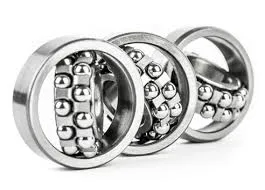
Nov . 11, 2024 23:12 Back to list
magnetic bearings theory design and application to rotating machinery
Magnetic Bearings Theory, Design, and Applications in Rotating Machinery
Magnetic bearings represent an innovative approach to supporting rotating machinery, offering significant advantages over traditional mechanical bearings. With the increasing demand for high speed, precision, and reliability in various industrial applications, the theory and design of magnetic bearings have garnered considerable attention from engineers and researchers alike.
Theory of Magnetic Bearings
At the core of magnetic bearings is the principle of magnetic levitation, which allows a rotor to be suspended in a magnetic field without any physical contact with the bearing surfaces. This is primarily achieved using electromagnets or permanent magnets. In electromagnet-based systems, the magnetic fields can be actively controlled to maintain rotor position, providing high levels of precision and efficiency.
The key components of a magnetic bearing system typically include the rotor, stator, and control electronics. The rotor is the rotating part of the machinery, while the stator contains the magnets or electromagnetic coils that exert force on the rotor. Through feedback control systems, the position and movement of the rotor are constantly monitored, enabling precise adjustments to the magnetic fields to counteract any disturbances.
Design Considerations
Designing magnetic bearings involves several critical considerations to ensure optimal performance. One significant factor is the choice between active and passive magnetic bearings. Active magnetic bearings, which use electromagnetic coils and feedback control systems, allow for greater adaptability and control, especially in dynamic operating conditions. Passive magnetic bearings rely on permanent magnets and are generally simpler in design, but they can exhibit limitations in terms of adjustability and stability under varying loads.
Another important aspect of design is the configuration of the magnetic field. Common configurations include radial and axial bearings. Radial bearings support loads from the side, while axial bearings support loads along the axis of rotation. Designers must consider factors such as load capacity, stiffness, and damping when choosing the appropriate configuration for specific applications.
magnetic bearings theory design and application to rotating machinery

Thermal effects and power consumption are also crucial considerations in the design of magnetic bearings. Efficient heat dissipation methods must be integrated into the system to prevent overheating, which could degrade performance and lead to failure. Additionally, minimizing power consumption is essential for enhancing the overall efficiency of the rotating machinery.
Applications in Rotating Machinery
Magnetic bearings are increasingly being adopted in various industries for a wide range of applications. One of the most prominent uses is in high-speed rotating machinery, such as turbines and motors. In these applications, magnetic bearings reduce friction and wear, resulting in improved energy efficiency and extended operational lifespans.
In the aerospace industry, magnetic bearings are utilized in turbo-machinery systems, where high reliability and low maintenance are critical. Their ability to operate without lubrication not only lowers the risk of contaminants but also enables operation in extreme environments, such as those found in space.
The oil and gas sector also benefits significantly from magnetic bearing technology. For instance, magnetic bearings are employed in centrifugal compressors, where they minimize mechanical failure and enhance operational reliability. The reduced maintenance requirements directly translate to lower operational costs, making magnetic bearings an attractive option for long-term projects.
Moreover, the rise of renewable energy technologies has opened new avenues for the application of magnetic bearings. In wind turbine generators, for example, magnetic bearings can contribute to increased efficiency by reducing friction losses and providing robust fault tolerance.
Conclusion
In conclusion, the theory and design of magnetic bearings play a pivotal role in advancing the performance of rotating machinery. As industries continue to seek ways to improve efficiency, reliability, and ease of maintenance, magnetic bearings offer a compelling solution. Continued research and development will no doubt lead to even more innovative applications and enhancements, further solidifying the importance of magnetic bearings in modern engineering. The transition to these advanced technologies not only promises to transform the landscape of rotary machinery design but also paves the way for innovative solutions in various sectors, driving progress towards a more efficient and sustainable future.
Latest news
-
Durable Greenhouse Pillow Block Bearings for Reliable Ventilation
NewsAug.31,2025
-
Spherical Roller Bearings Applications: Heavy Duty, Self-Aligning
NewsAug.30,2025
-
Premium Deep Groove Ball Bearings | High Speed & Reliability
NewsAug.29,2025
-
Durable Scaffolding Clamps - Secure & Reliable Tube Connectors
NewsAug.28,2025
-
Common Failures in Thrust Ball Bearings and Solutions
NewsAug.22,2025
-
How Tapered Roller Bearings Can Take Shock Loads
NewsAug.22,2025
